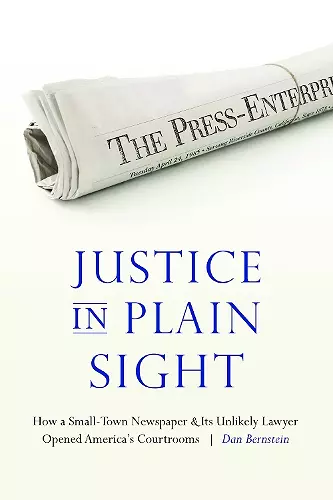Justice in Plain Sight
How a Small-Town Newspaper and Its Unlikely Lawyer Opened America's Courtrooms
Format:Hardback
Publisher:University of Nebraska Press
Published:1st Jan '19
Currently unavailable, and unfortunately no date known when it will be back

2024 American Legacy Book Awards Winner
Justice in Plain Sight is the story of a hometown newspaper in Riverside, California, that set out to do its job: tell readers about shocking crimes in their own backyard. But when judges slammed the courtroom door on the public, including the press, it became impossible to tell the whole story. Pinning its hopes on business lawyer Jim Ward, whom Press-Enterprise editor Tim Hays had come to know and trust, the newspaper took two cases to the U.S. Supreme Court in the 1980s. Hays was convinced that the public—including the press—needed to have these rights and needed to bear witness to justice because healing in the aftermath of a horrible crime could not occur without community catharsis. The newspaper won both cases and established First Amendment rights that significantly broadened public access to the judicial system, including the right for the public to witness jury selection and preliminary hearings.
Justice in Plain Sight is a unique story that, for the first time, details two improbable journeys to the Supreme Court in which the stakes were as high as they could possibly be (and still are): the public's trust in its own government.
"The considerable research, numerous interviews, and primary documentation combine to make Justice in Plain Sight a comprehensive look at two landmark cases and the underdog newspaper that ensured that the justice process can't operate in secret."—Jeff Fleischer, Foreword Reviews
"Whether you're a lawyer or a history buff, you will enjoy reading about how an unlikely small-town Riverside newspaper and lawyers successfully fought to open public access to criminal proceedings in the United States."—Theresa Han Savage, Riverside Lawyer
"Justice in Plain Sight provides a timely and intriguing glimpse at the operation of an earlier Supreme Court, which was functioning in the aftermath of the political and social upheaval of the 1970s."—Kim Himstreet, Bend Bulletin
"It is one thing for an attorney litigating an access case today to know and memorize the Press-Enterprise test. But as Bernstein’s book reveals, it is a far more interesting thing to understand the backstory about how that rule evolved and to appreciate the hard-fought efforts of so many people that went into it."—Clay Calvert, Criminal Law and Criminal Justice Books
“Dan Bernstein’s new book disproves two stereotypes about history: First, that it’s made only by the famous, and second, that it’s boring. This is a tale of small-town heroes, newspaper professionals, and lawyers. . . . In Dan’s capable hands, it’s smart, funny, and above all, enlightening.”—George Rodrigue, two-time winner of the Pulitzer Prize and president and editor of the Cleveland Plain Dealer
“I simply loved Justice in Plain Sight. It is like a fairy tale with a landscape populated by now-extinct beasts. . . . For those who want to understand what journalism can mean to a community, here’s a well-told story of a very good newspaper.”—Donald E. Graham, former publisher of the Washington Post
“As courts and the media today face political criticism and threats, Bernstein’s story of the paper’s landmark victories is a timely reminder of how crucial public access is to the integrity of our judicial system.”—Marcia Coyle, chief Washington correspondent of the National Law Journal and author of The Roberts Court: The Struggle for the Constitution
“A suspenseful, true-life legal page-turner about honest men and women standing up for freedom. A thoroughly compelling and engaging read.”—Jonathan Eig, New York Times best-selling author of Ali: A Life
“The doors of America’s courtrooms are open today because one small newspaper in California refused to let justice take place in secret. Justice in Plain Sight is a long-overdue look at the legal fight that changed the history of the First Amendment.”—David E. McCraw, vice president and deputy general counsel, the New York Times Company
“This book, which tells the highly interesting story behind two Supreme Court precedents, has it all: heinous crimes, protective judges, dogged journalists, skilled local lawyers, captious Supreme Court justices, and a very fortunate public that, thanks to the Press-Enterprise, secured a First Amendment right to attend jury selection and preliminary hearings.”—James T. Hamilton, Hearst Professor of Communication at Stanford University
ISBN: 9781496202017
Dimensions: unknown
Weight: unknown
280 pages